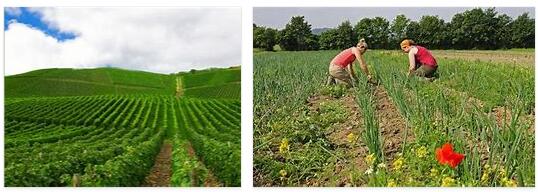Although it now plays, as in all Western countries, a completely marginal role (it contributes by less than 2 percentage points to the formation of GDP), German agriculture has recently shown an interesting dynamic. Traditionally oriented to the production of cereals, potatoes and products for industrial processing, the agriculture of the western regions has been able to profit greatly from the provisions of the Community Agricultural Policy (PAC), has continued to proceed on the path of ever more intense mechanization, has achieved a rationalization of crops and land assets (with an increase in the average size of the farm, although still very modest, except in the north-western part), has further favored crops extensive, allocating the crops to industrial processing or to feed livestock; similarly, the livestock sector, especially as regards certain products (milk, dairy products, sausages) has greatly strengthened. In both sectors, there was a clear trend (which mainly concerns small companies) towards the conversion towards quality, organic, niche productions, destined for a market that is increasingly willing to spend in order to guarantee a healthy and natural nutrition.
In general, polyculture prevails over the whole of the territory of the western regions, although depending on the soil and climate there are areas with typical cultivation specializations; yields appear very high, but overall production does not meet internal needs. In the eastern regions a few hundred large state-owned companies were formed, powerfully mechanized and oriented both to crop experimentation and to processes of productive intensification; in parallel, there were about 4000 cooperative companies. The small private property had been preserved, but it had negligible economic weight. After the reunification, part of the confiscated land was returned to the previous owners. Overall, the profitability of the Eastern agriculture was also inferior to western agriculture, above all as a consequence of unfavorable pedological and climatic characteristics, which concern almost the entire northern flat portion, but also marshy, and peaty soils (in the whole country only about 50% of the territory is exploitable for agricultural purposes). The main productions of the country are cereals: in the first place wheat, in the most fertile areas and in the southern basins to the west, in Saxony to the east; barley, used both in human and animal nutrition, and in the manufacture of beer; rye, also used for bread making, which adapts to poor and cold soils and is grown mainly in the northern plains, but corn and oats are less relevant. L’ very intense potato cultivation is carried out almost everywhere, with areas of special intensity, such as in the Elbe basin; beetroot is also present throughout the country, while hops, used in the production of beer, are grown in Bavaria, in the Main valley, in Brandenburg, and the modest quantity of grapes (from which excellent white wines are obtained) almost exclusively at the western edge of the country (Moselle valley, Palatinate). Visit sunglassestracker.com for Germany interesting cities and central European idyll.
Furthermore, sunflowers, rapeseed and tobacco are produced, and some importance is given to the cultivation of vegetables (cabbage, onions) and fruit (apples, pears, plums). The forests, which cover more than a quarter of the territory, are rationally exploited throughout Germany and provide an interesting quantity of timber (which feeds industrial production, the pulp and paper industry); In both western and eastern regions, forestry is highly developed and the woodland heritage, whether or not used for economic purposes, is protected by environmental laws and is constantly growing. Breeding, which contributes 70% to the income of the primary sector, is particularly important and well cared for: both cattle (with particular concentrations in Friesland, Saxony, Bavaria), mainly used for milk and conducted in rational plants often of large size, both pork, which is practiced almost everywhere and especially in small farms, for the use of meat. Livestock products make Germany one of the main exporters in the sector: in particular for milk, meat and cheeses; However, domestic production is not fully able to satisfy consumption (meat and eggs are imported). It is important to consider that the policy followed by Germany within the Community has led not only to the protection and support of German agricultural production, but in particular the zootechnical ones, effectively spread throughout the country and to some extent of interest to all farms; Community support and the gradual revaluation of the value of zootechnical products have favored the increase in production in livestock farming. In 2001, following the discovery of numerous cases of breeding area. In 2001, following the discovery of numerous cases of breeding area. In 2001, following the discovery of numerous cases of BSE, many public incentives have been directed towards organic farming. Fishing is not particularly relevant, but it has good traditions, and is practiced in the North Sea, the Barents Sea and along the coasts of Iceland, Greenland, Newfoundland. The main fishing ports are those of Bremenhaven, Stralsund, Hamburg, Cuxhaven, Kiel, Rostock and Wiesmar.
